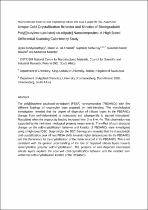 ResearchSpace
ResearchSpace
Unique cold-crystallization behavior and kinetics of biodegradable poly[(butylene succinate)-co adipate] nanocomposites: a high speed differential scanning calorimetry study
JavaScript is disabled for your browser. Some features of this site may not work without it.
- ResearchSpace
- →
- Research Publications/Outputs
- →
- Journal Articles
- →
- View Item
| dc.contributor.author |
Bandyopadhyay, J

|
|
| dc.contributor.author |
Al-Thabaiti, SA

|
|
| dc.contributor.author |
Ray, SS

|
|
| dc.contributor.author |
Basahel, SN

|
|
| dc.contributor.author |
Mokhtar, M

|
|
| dc.date.accessioned | 2014-12-22T07:42:32Z | |
| dc.date.available | 2014-12-22T07:42:32Z | |
| dc.date.issued | 2014-08 | |
| dc.identifier.citation | Bandyopadhyay, J, Al-Thabaiti, S.A, Ray, S.S, Basahel, S.N and Mokhtar, M. 2014. Unique cold-crystallization behavior and kinetics of biodegradable poly[(butylene succinate)-co adipate] nanocomposites: a high speed differential scanning calorimetry study. Macromolecular Materials and Engineering, vol.299(8), pp 939-952 | en_US |
| dc.identifier.issn | 1438-7492 | |
| dc.identifier.uri | http://hdl.handle.net/10204/7829 | |
| dc.description | Copyright: 2014 Wiley. Abstract only.The definitive version is published in Macromolecular Materials and Engineering, vol.299(8), pp 939-952 | en_US |
| dc.description.abstract | The poly[(butylene succinate)-co-adipate] (PBSA) nanocomposites (PBSANCs) with five different loadings of organoclay were prepared by melt-blending. The morphological investigation revealed that the degree of dispersion of silicate layers in the PBSANCs changes from well-delaminated to intercalated and subsequently to stacked intercalated-flocculated when the organoclay loading increased from 3 to 6 wt.-%. This observation was supported by the melt-state rheological property measurements. The effect of such structural changes on the cold-crystallization behavior and kinetics of PBSANCs were investigated using a high-speed DSC. Surprisingly, the DSC thermograms revealed that the characteristic cold-crystallization peak of neat PBSA shifts towards higher temperatures for the PBSANCs and that the kinetics for the crystallization of the matrix retarded in the PBSANCs. This is not consistent with the general understanding of the role of dispersed silicate layers towards semicrystalline polymer cold-crystallization. The presence of well-dispersed intercalated silicate layers explains the observed cold-crystallization behavior and the retarded non-isothermal cold-crystallization kinetics of the PBSANCs. | en_US |
| dc.language.iso | en | en_US |
| dc.publisher | Wiley | en_US |
| dc.relation.ispartofseries | Workflow;13757 | |
| dc.subject | Cold-crystallization behavior and kinetics | en_US |
| dc.subject | High-speed DSC | en_US |
| dc.subject | Poly[(butylene succinate)-co-adipate] nanocomposites | en_US |
| dc.subject | Nanocomposites | en_US |
| dc.title | Unique cold-crystallization behavior and kinetics of biodegradable poly[(butylene succinate)-co adipate] nanocomposites: a high speed differential scanning calorimetry study | en_US |
| dc.type | Article | en_US |
| dc.identifier.apacitation | Bandyopadhyay, J., Al-Thabaiti, S., Ray, S., Basahel, S., & Mokhtar, M. (2014). Unique cold-crystallization behavior and kinetics of biodegradable poly[(butylene succinate)-co adipate] nanocomposites: a high speed differential scanning calorimetry study. http://hdl.handle.net/10204/7829 | en_ZA |
| dc.identifier.chicagocitation | Bandyopadhyay, J, SA Al-Thabaiti, SS Ray, SN Basahel, and M Mokhtar "Unique cold-crystallization behavior and kinetics of biodegradable poly[(butylene succinate)-co adipate] nanocomposites: a high speed differential scanning calorimetry study." (2014) http://hdl.handle.net/10204/7829 | en_ZA |
| dc.identifier.vancouvercitation | Bandyopadhyay J, Al-Thabaiti S, Ray S, Basahel S, Mokhtar M. Unique cold-crystallization behavior and kinetics of biodegradable poly[(butylene succinate)-co adipate] nanocomposites: a high speed differential scanning calorimetry study. 2014; http://hdl.handle.net/10204/7829. | en_ZA |
| dc.identifier.ris | TY - Article AU - Bandyopadhyay, J AU - Al-Thabaiti, SA AU - Ray, SS AU - Basahel, SN AU - Mokhtar, M AB - The poly[(butylene succinate)-co-adipate] (PBSA) nanocomposites (PBSANCs) with five different loadings of organoclay were prepared by melt-blending. The morphological investigation revealed that the degree of dispersion of silicate layers in the PBSANCs changes from well-delaminated to intercalated and subsequently to stacked intercalated-flocculated when the organoclay loading increased from 3 to 6 wt.-%. This observation was supported by the melt-state rheological property measurements. The effect of such structural changes on the cold-crystallization behavior and kinetics of PBSANCs were investigated using a high-speed DSC. Surprisingly, the DSC thermograms revealed that the characteristic cold-crystallization peak of neat PBSA shifts towards higher temperatures for the PBSANCs and that the kinetics for the crystallization of the matrix retarded in the PBSANCs. This is not consistent with the general understanding of the role of dispersed silicate layers towards semicrystalline polymer cold-crystallization. The presence of well-dispersed intercalated silicate layers explains the observed cold-crystallization behavior and the retarded non-isothermal cold-crystallization kinetics of the PBSANCs. DA - 2014-08 DB - ResearchSpace DP - CSIR KW - Cold-crystallization behavior and kinetics KW - High-speed DSC KW - Poly[(butylene succinate)-co-adipate] nanocomposites KW - Nanocomposites LK - https://researchspace.csir.co.za PY - 2014 SM - 1438-7492 T1 - Unique cold-crystallization behavior and kinetics of biodegradable poly[(butylene succinate)-co adipate] nanocomposites: a high speed differential scanning calorimetry study TI - Unique cold-crystallization behavior and kinetics of biodegradable poly[(butylene succinate)-co adipate] nanocomposites: a high speed differential scanning calorimetry study UR - http://hdl.handle.net/10204/7829 ER - | en_ZA |





